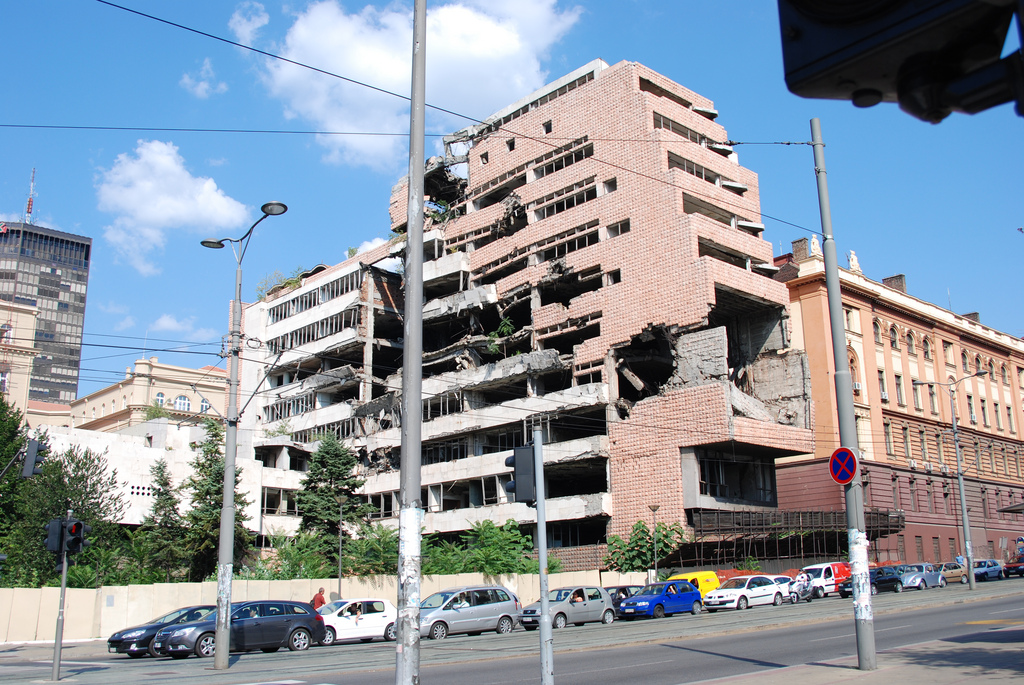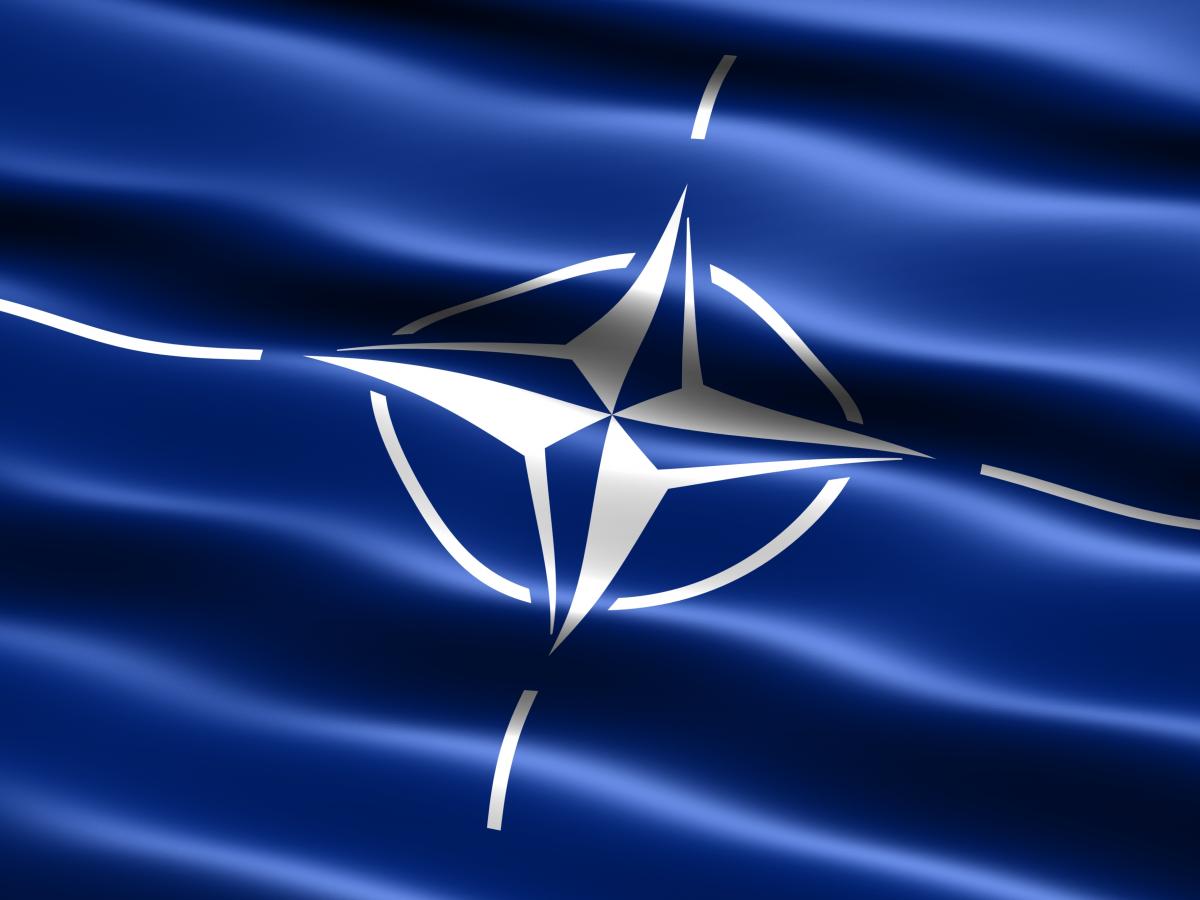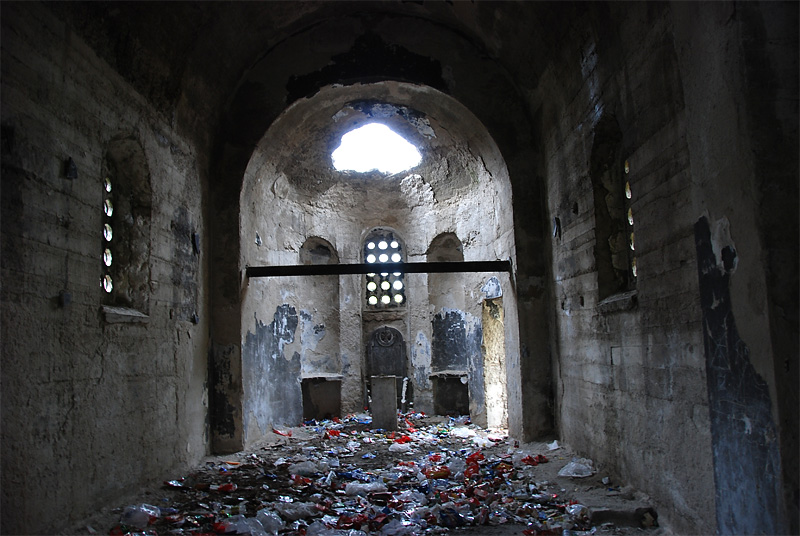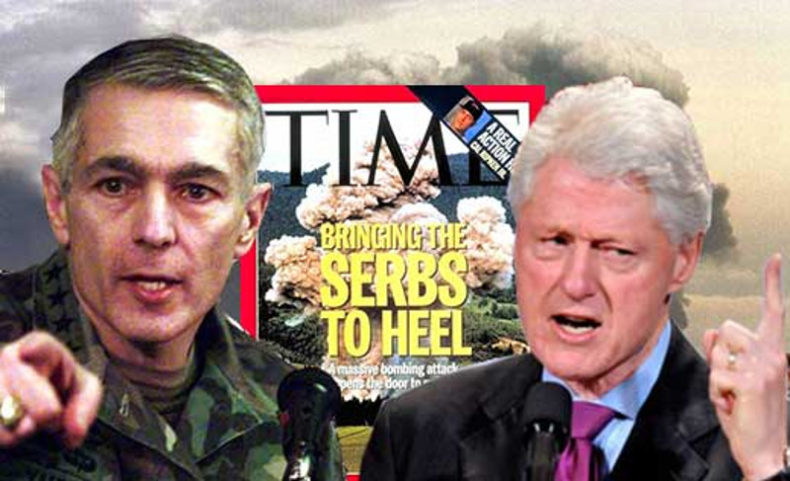
Views: 3613
The current political process of acceptance of the quasi-independent state of Kosovo to the full UN’s UNESCO’s membership opened once again a question of NATO’s military intervention against the Federal Republic of Yugoslavia (the FRY) in March−June 1999 as a foundation for Kosovo’s secession from Serbia and its unilateral proclamation of a quasi-independence in February 2008. Kosovo became the first and only European state up today that is ruled by the terrorist warlords as a party’s possession – the (Albanian) Kosovo Liberation Army (the KLA). The aim of this article is to investigate the nature of NATO’s war on Yugoslavia in 1999.
Terrorism and Kosovo independence
 The KLA terrorists with support by the US’ and the EU’s administrations launched a full scale of violence in December 1998 for the only purpose to provoke the NATO’s military intervention against the FRY as a precondition for Kosovo secession from Serbia hopefully followed by internationally recognized independence. In order to finally resolve the “Kosovo Question” in the favor of the Albanians, the US’ Clinton administration brought two confronting sides to formally negotiate in the French castle of Rambouillet in France in February 1999 but in fact to impose an ultimatum to Serbia to accept de facto secession of Kosovo. Regardless of the fact that the Rambouillet ultimatum de iure recognized Serbia’s territorial integrity, the disarmament of terrorist KLA and did not mention Kosovo independence from Serbia, as the conditions of the final agreement were in essence highly favorable to the KLA and its secessionist project towards independent Kosovo, Serbia simply rejected them. The US’s answer was a military action led by NATO as a “humanitarian intervention” in order to directly support the Kosovo Albanian separatism. Therefore, on March 24th, 1999 the NATO started its military operation against the FRY which lasted till June 10th, 1999. Why the UN’s Security Council was not asked for the approval of the operation is clear from the following explanation:
The KLA terrorists with support by the US’ and the EU’s administrations launched a full scale of violence in December 1998 for the only purpose to provoke the NATO’s military intervention against the FRY as a precondition for Kosovo secession from Serbia hopefully followed by internationally recognized independence. In order to finally resolve the “Kosovo Question” in the favor of the Albanians, the US’ Clinton administration brought two confronting sides to formally negotiate in the French castle of Rambouillet in France in February 1999 but in fact to impose an ultimatum to Serbia to accept de facto secession of Kosovo. Regardless of the fact that the Rambouillet ultimatum de iure recognized Serbia’s territorial integrity, the disarmament of terrorist KLA and did not mention Kosovo independence from Serbia, as the conditions of the final agreement were in essence highly favorable to the KLA and its secessionist project towards independent Kosovo, Serbia simply rejected them. The US’s answer was a military action led by NATO as a “humanitarian intervention” in order to directly support the Kosovo Albanian separatism. Therefore, on March 24th, 1999 the NATO started its military operation against the FRY which lasted till June 10th, 1999. Why the UN’s Security Council was not asked for the approval of the operation is clear from the following explanation:
“Knowing that Russia would veto any effort to get UN backing for military action, NATO launched air strikes against Serbian forces in 1999, effectually supporting the Kosovar Albanian rebels”.[1]
The crucial feature of this operation was a barbarian, coercive, inhuman, illegal, and above all merciless bombing of Serbia for almost three months. Nevertheless, that the NATO’s military intervention against the FRY – Operation Allied Force, was propagated by its proponents as a purely humanitarian operation, it is recognized by many Western and other scholars that the US and its client states of the NATO had mainly political and geostrategic aims that led them to this military action.
The legitimacy of the intervention of the brutal coercive bombing of both military and civilian targets in Kosovo province and the rest of Serbia became immediately controversial as the UN’s Security Council did not authorize the action. Surely, the action was illegal according to the international law but it was formally justified by the US’ administration and the NATO’s spokesman as legitimate for the reason that it was unavoidable as all diplomatic options were exhausted to stop the war. However, a continuation of the military conflict in Kosovo between the KLA and Serbia’s state security forces would threaten to produce a humanitarian catastrophe and generate political instability in the region of the Balkans. Therefore, “in the context of fears about the ‘ethnic cleansing’ of the Albanian population, a campaign of airstrikes, conducted by US-led NATO forces”[2] was executed with a final result of the withdrawal of Serbia’s forces and administration from the province: that was exactly the main requirement of the Rambouillet ultimatum.
It is of crucial importance to stress at least five facts in order to properly understand the nature and aims of NATO’s military intervention against Serbia and Montenegro in 1999:
- It was bombed only the Serbian side involved in the conflict in Kosovo while the KLA was allowed and even fully sponsored to continue its terroristic activities either against Serbia’s security forces or the Serbian civilians.
- The ethnic cleansing of the Albanians by the Serbian security forces was only a potential action (in fact, only in the case of direct NATO’s military action against the FRY) but not a real fact as a reason for NATO to start coercive bombing of the FRY.
- The NATO’s claim that the Serbian security forces killed up to 100.000 Albanian civilians during the Kosovo War of 1998−1999 was pure propaganda lie as after the war it was found only 3.000 bodies of all nationalities in Kosovo.
- The bombing of the FRY was promoted as the “humanitarian intervention”, which means as legitimate and defensible action, that scholarly should mean “…military intervention that is carried out in pursuit of humanitarian rather than strategic objectives”.[3] However, today it is quite clear that the intervention had political and geostrategic ultimate objectives but not the humanitarian one.
- The NATO’s military intervention in 1999 was a direct violation of the UN principles of international conduct as it is said in the UN Charter that:
“All Members shall refrain in their international relations from the threat or use of force against the territorial integrity or political independence of any state, or in any other manner inconsistent with the Purposes of the United Nations”.[4]
What happened in Kosovo when NATO started its military campaign was quite expected and above all wishful by the US administration and the KLA’s leaders: Serbia made a much stronger military assault on the KLA and the ethnic Albanians who supported it. As a consequence, there was a significantly increased number of refugees – up to 800.000 according to the CIA’s and the UN’s sources. However, the US’s administration presented all of these refugees as the victims of the Serb-led policy of systematic and well-organized ethnic cleansing (alleged “Horse Shoe” operation) regardless of the facts that:
- The overwhelming majority of them were not the real refugees but rather “TV refugees” for the Western mass media.
- A minority of them were simply escaping from the consequences of NATO’s merciless bombing.
- Just part of the refugees has been the real victims of the Serbian “bloody revenge” policy for NATO’s destruction of Serbia.
Nevertheless, the final result of the NATO’s sortie campaign against the FRY was that the UN’s Security Council formally authorized the NATO’s (under the official name of KFOR)[5] ground troops to occupy Kosovo and give to the KLA free hands to continue and finish with the ethnic cleansing of the province from all non-Albanians. That was the beginning of the making of the Kosovo independence which was finally proclaimed by the Kosovo Parliament (without national referenda) in February 2008 and immediately recognized by the main Western countries.[6] In such a way, Kosovo became the first legalized European mafia state.[7] Nevertheless, in addition, the EU’s and the US’s policies to rebuild peace on the territory of ex-Yugoslavia did not manage to deal successfully with probably the main and most serious challenge to their proclaimed task to re-establish the regional stability and security: al-Qaeda linked terrorism, especially in Bosnia-Herzegovina but also in Kosovo-Metochia.[8]
 Members of the U.S.’s sponsored Kosovo Liberation Army in 1999 during the NATO’s aggression on the Federal Republic of Yugoslavia
Members of the U.S.’s sponsored Kosovo Liberation Army in 1999 during the NATO’s aggression on the Federal Republic of Yugoslavia
Dilemmas
According to NATO’s sources, there were two objectives of the alliance’s military intervention against the FRY in March−June 1999:
- To force Slobodan Miloshevic, a President of Serbia, to accept a political plan for the autonomy status of Kosovo (designed by the US administration).
- To prevent (alleged) ethnic cleansing of the Albanians by Serbia’s authorities and their armed forces.
However, while the political objective was in principle achieved, the humanitarian one was with quite opposite results. By bombing the FRY in the three airstrikes phases the NATO succeeded to force Miloshevic to sign a political-military capitulation in Kumanovo on June 9th, 1999, to handle Kosovo to the NATO’s administration and practically to authorize the KLA’s-led Islamic terror against the Christian Serbs.[9] A direct outcome of the operation was surely negative as NATO’s sorties caused approximately 3000 killed Serbian military and civilians in addition to an unknown number of killed ethnic Albanians. An indirect impact of the operation cost a number of the ethnic Albanian killed civilians followed by massive refugee flows of Kosovo Albanians[10] as it provoked the Serbian police and the Yugoslav army to attack. We can not forget that the greatest scale of war crimes against the Albanian civilians in Kosovo during the NATO’s bombing of the FRY was most probably, according to some research investigations, committed by the Krayina refugee Serbs from Croatia who were after August 1995 in the uniforms of the regular police forces of Serbia as a matter of revenge for the terrible Albanian atrocities committed in the Krayina region in Croatia only several years ago against the Serb civilians[11] when many of Kosovo Albanians fought the Serbs in the Croatian uniforms.
The fundamental dilemma is why NATO directly supported the KLA – an organization that was previously clearly called as a “terrorist” by many Western Governments including and the US’s one? It was known that a KLA’s warfare of partisan strategy[12] was based only on the direct provoking of Serbia’s security forces to respond by attacking the KLA’s posts with an unavoidable number of civilian casualties. However, these Albanian civilian victims were not understood by the NATO’s authorities as “collateral damage” but rather as the victims of deliberate ethnic cleansing. Nevertheless, all civilian victims of NATO’s bombing in 1999 were presented by the NATO’s authorities exactly as “collateral damage” of the NATO’s “just war”[13] against the oppressive regime in Belgrade.
Here we will present the basic (academic) principles of a “just war”:
- Last resort – All diplomatic options are exhausted before the force is used.
- Just cause – The ultimate purpose of the use of force is to self-defend its own territory or people from military attack by others.
- Legitimate authority – To imply the legitimate constituted Government of a sovereign state, but not by some private (individual) or group (organization).
- Right intention – The use of force, or war, had to be prosecuted for morally acceptable reasons, but not based on revenge or the intention to inflict the damage.
- Reasonable prospect of success – The use of force should not be activated in some hopeless cause, in which human lives are exposed for no real benefits.
- Proportionality – Military intervention has to have more benefits than losses.
- Discrimination – The use of force must be directed only at the purely military targets as the civilians are considered to be innocent.
- Proportionality – The used force has to be no greater than it is needed to achieve morally acceptable aims and must not be greater than the provoking cause.
- Humanity – The use of force cannot be directed ever against the enemy personnel if they are captured (the prisoners of war) or wounded.[14]
If we analyze NATO’s military campaign in regard to just above presented basic (academic) principles of the “just war”, the fundamental conclusions will be as following:
- The US’s administration in 1999 did not use any real diplomatic effort to settle the Kosovo crisis as Washington simply gave the political-military ultimatum in Rambouillet only to one side (Serbia) to either accept or not in full required blackmails: 1) To withdraw all Serbian military and police forces from Kosovo; 2) To give Kosovo administration to the NATO’s troops; and 3) To allow the NATO’s troops to use a whole territory of Serbia for the transit purpose. In the other words, the basic point of the US’s ultimatum to Belgrade was that Serbia will voluntarily become a US colony but without Kosovo province. Even the US’s President at that time – Bill Clinton, confirmed that Miloshevic’s rejection of the Rambouillet ultimatum was understandable and logical. It can be said that Serbia in 1999 did the same as the Kingdom of Serbia did in July 1914 by rejecting the Austro-Hungarian ultimatum which was also absurd and abusive.[15]
- This principle was absolutely misused by the NATO’s administration as no one NATO’s country was attacked or occupied by the FRY. In Kosovo at that time, it was a classic anti-terroristic war launched by the state authorities against the illegal separatist movement but fully sponsored in this case by neighboring Albania and NATO.[16] In the other words, this second principle of the “just war” can be only applied to the anti-terroristic operations by the state authorities of Serbia in Kosovo province against the KLA rather than to NATO’s military intervention against the FRY.
- The Legitimate authority principle in the Kosovo conflict case of 1998−1999 can be applied only to Serbia and her legitimate state institutions and authority which were recognized as legitimate by the international community and above all by the UN.
- The morally acceptable reasons officially used by NATO’s authorities to justify its own military action against the FRY in 1999 were quite unclear and above all unproved and misused for the very political and geostrategic purposes in the coming future. Today we know that NATO’s military campaign was not based on the morally proved claims to stop a mass expulsion of the ethnic Albanians from their homes in Kosovo as a mass number of displaced persons appeared during the NATO’s military intervention but not before.
- The consequences of the fifth principle were selectively applied as only Kosovo Albanians benefited from both short and long term perspectives by the NATO’s military engagement in the Balkans in 1999.
- The sixth principle also became practically applied only to Kosovo Albanians what was in fact and the ultimate task of the US and NATO administrations. In the other words, the benefits of the action were overwhelmingly single-sided. However, from the long-term geostrategic and political aspects, the action was very profitable with a minimum loss for the Western military alliance during the campaign.
- The practical consequences of the seventh principle became mostly criticized as NATO obviously did not make any difference between the military and civilian targets. Moreover, the NATO’s alliance deliberately bombed much more civilian objects and non-combat citizens than the military objects and personnel. However, all civilian victims of the bombing of all nationalities became simply presented by NATO’s authority as an unavoidable “collateral damage”, but in fact, it was a clear violation of the international law and one of the basic principles of the concept of a “just war”.
- The eighth principle of a “just was” surely was not respected by NATO as the used force was much higher as needed to achieve proclaimed tasks and above all was much stronger than the opposite side had. However, the morally acceptable aims of the western policymakers were based on the wrong and deliberately misused “facts” in regard to the ethnic Albanian victims of the Kosovo War in 1998−1999 as it was primarily with the “brutal massacre of forty-five civilians in the Kosovo village of Račak in January 1999”[17] which became a formal pretext for the NATO’s intervention. Nevertheless, it is known today that those Albanian “brutally massacred civilians” were in fact the members of the KLA killed during the regular fight but not executed by the Serbian security forces.[18]
- Only the last principle of a “just war” was respected by NATO for the very reason that there were no captured soldiers from the opponent side. The Serbian authorities also respected this principle as all two NATO’s captured pilots were treated as prisoners of war according to the international standards and even were free very soon after the imprisonment.[19]
 Crucified Christian (Serb Orthodox) Kosovo after the war by the KLA’s members in power
Crucified Christian (Serb Orthodox) Kosovo after the war by the KLA’s members in power
Conclusions
The crucial conclusions of the article after the investigation of the nature of NATO’s “humanitarian” military intervention in Kosovo in 1999 are:
- The NATO’s military intervention against the FRY during the Kosovo War in 1998−1999 was done primarily for political and geostrategic purposes.
- A declarative “humanitarian” nature of the operation just served as a formal moral framework of the realization of the genuine goals of the post-Cold War US’s policy at the Balkans which foundations were laid down by the Dayton Accords in November 1995.
- The US’s administration of Bill Clinton used the terrorist KLA for pressing and blackmailing the Serbian Government to accept the ultimatum by Washington to transform Serbia into the US’s military, a political and economic colony with a NATO’s membership in the future for the exchange of formal preservation of Serbia’s territorial integrity.
- The Western Governments originally labeled the KLA as a “terrorist organization” – that is combat strategy of direct provoking Serbia’s security forces was morally unacceptable and would not result in either diplomatic or military support.
- During the Kosovo War in 1998−1999, the KLA basically served as NATO’s ground forces in Kosovo for direct destabilization of Serbia’s state security which was militarily defeated at the very beginning of 1999 by Serbia’s regular police forces.
- The NATO’s sorties in 1999 have as the main goal to force Belgrade to give Kosovo province to the US’s and EU’s administration in order to transform it into the biggest US’s and NATO’s military base in Europe.
- The NATO’s “humanitarian” intervention in 1999 against the FRY violated almost all principles of the “just war” and the international law – an intervention that became one of the best examples in the post-Cold War history of unjust use of coercive power for the political and geostrategic purposes and at the same time a classic case of coercive diplomacy that fully engaged the Western Governments.
- Some 50.000 NATO’s troops displaced in Kosovo after June 10th, 1999 did not fulfill the basic tasks of their mission: 1) Demilitarization of the KLA as this paramilitary formation was never properly disarmed; 2) Protection of all Kosovo inhabitants as only up to January 2001 there were at least 700 Kosovo citizens murdered on the ethnic basis (most of them were the Serbs); 3) Stability and security of the province as most of the Serbs and other non-Albanians fled the province as a consequence of systematic ethnic cleansing policy committed by the KLA in power after June 1999.
- The US’s reward for the KLA’s loyalty was to install the army’s members to the key governmental posts of today “independent” Republic of Kosova which became the first European state administered by the leaders of the ex-terrorist organization who started immediately after the war to execute a policy of ethnic cleansing of all non-Albanian population and to Islamize the province.
- The ultimate national-political goal of the KLA in power in Kosovo is to include this province into the Greater Albania projected by the First Albanian Prizren League in 1878−1881 and for the first time realized during WWII.[20]
- Probably, the main consequence of the NATO’s occupation of Kosovo after June 1999 up today is a systematic destruction of the Christian (Serb) cultural inheritance and feature of the province followed by its obvious and comprehensive Islamization and therefore transformation of Kosovo into a new Islamic State.
- What concerns the case of the Kosovo crisis in 1998−1999, the first and authentic “humanitarian” intervention was that of Serbia’s security forces against the terroristic KLA in order to preserve the human lives of the ethnic Serbs and anti-KLA Albanians in the province.
- The Balkan Stability Pact for both Bosnia-Herzegovina and Kosovo-Metochia attempted to the under-emphasize the traditional concept of sovereignty giving a full practical possibility to the UN’s (in fact the West’s) administrative control over these two ex-Yugoslav territories.[21]
- The NATO’s “humanitarian” intervention in 1999 against the FRY clearly violated the recognized international standards of non-intervention, based on the principle of the “inviolability of borders” going beyond the idea of “just war” according to which the self-defense is the crucial reason, or at least formal justification, for the use of force.
- While the NATO declaratively fulfilled “the international responsibility to protect” (the ethnic Albanians) by heavily bombing Serbia and too much little extent Montenegro, bypassing the UN’s Security Council it is clear that this 78-day terror effort was counterproductive as “creating as much human suffer-refugees as it relieved”.[22]
- The fundamental question in regard to the Kosovo “humanitarian” interventions today is why the Western Governments are not taking another “humanitarian” coercive military intervention after June 1999 in order to prevent further ethnic cleansing and brutal violation of human rights against all non-Albanian population in Kosovo but above all against the Serbs?
- Finally, NATO’s military intervention was seen by many social constructivists as a phenomenon of “warlike democracies” as a demonstration of how the ideas of liberal democracy “undermine the logic of democratic peace theory”.[23]
 Prof. Dr. Vladislav B. Sotirovic
Prof. Dr. Vladislav B. Sotirovic
www.global-politics.eu/sotirovic
sotirovic@global-politics.eu
© Vladislav B. Sotirović 2016
____________________
Personal disclaimer: The author writes for this publication in a private capacity which is unrepresentative of anyone or any organization except for his own personal views. Nothing written by the author should ever be conflated with the editorial views or official positions of any other media outlet or institution.
References
[1] S. L. Spiegel, J. M. Taw, F. L. Wehling, K. P. Williams, World Politics in a New Era, Thomson Wadsworth, 2004, 319.
[2] A. Heywood, Global Politics, New York: Palgrave Macmillan, 2011, 320.
[3] Ibid., 319.
[4] J. Haynes, P. Hough, Sh. Malik, L. Pettiford, World Politics, Harlow: Pearson Education Limited, 2011, 639.
[5] The 1244 UN Security Council Resolution on June 10th, 1999. The KFOR’s basic responsibilities were:
- To protect aid operations.
- To protect all Kosovo population.
- To create stable security in the province in order that the international administration can function normally.
[6] This recognition of the self-proclaimed Kosovo independence from a democratic country of Serbia with a pro-Western regime basically gave victory to the Albanian Kosovo radicals of the ethnic cleansing after June 1999. The Albanians from Kosovo started their atrocities against the Serbs immediately after the Kumanovo Agreement in June 1999 when the KLA returned back to Kosovo together with the NATO’s occupation ground troops. Up to February 2008, there were around 200.000 expelled Serbs from Kosovo and 1.248 non-Albanians who have been killed in some cases even very brutally. The number of kidnapped non-Albanians is still not known but presumably, the majority of them were killed. There were 151 Serb Orthodox spiritual and cultural monuments in Kosovo destroyed by the Albanians in addition to 213 mosques built with financial support from Saudi Arabia. Before Kosovo independence was proclaimed, there was 80 percent of graveyards were either completely destroyed or partially desecrated by the Albanians. On Kosovo right to independence, see [M. Sterio, The Right to Self-Determination under International Law: “Selfistans”, Secession, and the Rule of the Great Powers, New York−London: Routledge, Taylor & Francis Group, 2013, 116−129]. On secession from the point of the international law, see [M. G. Kohen, Secession: International Law Perspectives, New York: Cambridge University Press, 2006].
[7] T. Burghardt, “Kosovo: Europe’s Mafia State. Hub of the EU-NATO Drug Trail”, 22-12-2010, http://www.globalresearch.ca/kosovo-europe-s-mafia-state-hub-of-the-eu-nato-drug-trail/22486.
[8] J. Haynes, P. Hough, Sh. Malik, L. Pettiford, World Politics, Harlow: Pearson Education Limited, 2011, 588.
[9] On the “just peace”, see [P. Allan, A. Keller (eds.), What is a Just Peace?, Oxford−New York: Oxford University Press, 2006].
[10] According to the official Western sources, even up to 90 percent of the Kosovo Albanian population became refugees during NATO’s military intervention. Therefore, it should be the largest displacement of the civilians in Europe after WWII. Nevertheless, all of these Albanian refugees are unquestionably considered to be “expelled” from their homes by Serbia’s security forces and the Yugoslav army.
[11] For example, in the “Medak Pocket” operation on September 9th, 1993 there were killed around 80 Serbian civilians by the Croatian forces [В. Ђ. Мишина (уредник), Република Српска Крајина: Десет година послије, Београд: Добра воља Београд, 2005, 35] in which Kosovo Albanians served too.
[12] The “partisan” or “guerrilla” war is fought by irregular troops using mainly tactics that are fitting to the geographical features of the terrain. The crucial characteristic of the tactics of the partisan war is that it uses mobility and surprise but not direct frontal battles with the enemy. Usually, the civilians are paying the highest price in the course of the partisan war. In the other words, it is “war conducted by irregulars or guerrillas, usually against regular, uniformed forces, employing hit-and-run, ambush, and other tactics that allow smaller numbers of guerrillas to win battles against numerically superior, often heavily-armed regular forces” [P. R. Viotti, M. V. Kauppi, International Relations and World Politics: Secularity, Economy, Identity, Harlow: Pearson Education Limited, 2009, 544]. With regard to the Kosovo War in 1998−1999 the reconstruction of the Albanian guerrilla strategy is as following:
“…a police patrol is passing a village when a sudden fire is open and some policemen killed and wounded. The police return the fire and the further development depends on the strength of the rebellious unit engaged. If the village appears well protected and risky to attack by the ordinary units, the latter stops fighting and calls for additional support. It arrives usually as a paramilitary unit, which launches a fierce onslaught” [P. V. Grujić, Kosovo Knot, Pittsburgh, Pennsylvania: RoseDog Books, 2014, 193].
[13] The “just war” is considered to be a war that has a purpose to satisfy certain ethical standards, and therefore is (allegedly) morally justified.
[14] A. Heywood, Global Politics, New York: Palgrave Macmillan, 2011, 257.
[15] М. Радојевић, Љ. Димић, Србија у Великом рату 1914−1915, Београд: Српска књижевна задруга−Београдски форум за свет равноправних, 2014, 94−95.
[16] For instance, Albania supplied the Albanian Kosovo separatists with weapons in 1997 when around 700.000 guns were “stolen” by the Albanian mob from Albania’s army’s magazines but the majority of these weapons found their way exactly to neighboring Kosovo. The members of the KLA were trained in Albania with the help of the NATO’s military instructors and then sent to Kosovo.
[17] R. J. Art, K. N. Waltz (eds.), The Use of Force: Military Power and International Politics, Lanham−Boulder−New York−Toronto−Oxford: Rowman & Littlefield Publishers, Inc., 2004, 257.
[18] В. Б. Сотировић, Огледи из југославологије, Виљнус: приватно издање, 2013, 19−29.
[19] On the NATO’s “humanitarian” intervention in the FRY in 1999, see more in [G. Szamuely, Bombs for Peace: NATO’s Humanitarian War on Yugoslavia, Amsterdam: Amsterdam University Press, 2013].
[20] A Greater Albania as a project is “envisaged to be an area of some 90.000 square kilometers (36.000 square miles), including Kosovo, Greece, Macedonia, Serbia and Montenegro” [J. Haynes, P. Hough, Sh. Malik, L. Pettiford, World Politics, Harlow: Pearson Education Limited, 2011, 588].
[21] R. Johnson, “Reconstructing the Balkans: The effects of a global governance approach”, M. Lederer, P. Müller (eds.), Criticizing Global Governance, New York: Palgrave Macmillan, 2005, 177.
[22] A. F. Cooper, J. Heine, R. Thakur (eds.), The Oxford Handbook of Modern Diplomacy, Oxford−New York: Oxford University Press, 2015, 766.
[23] J. Haynes, P. Hough, Sh. Malik, L. Pettiford, World Politics, Harlow: Pearson Education Limited, 2011, 225.
Origins of images: Facebook, Twitter, Wikimedia, Wikipedia, Flickr, Google, Imageinjection, Public Domain & Pinterest.
Read our Disclaimer/Legal Statement!
Donate to Support Us
We would like to ask you to consider a small donation to help our team keep working. We accept no advertising and rely only on you, our readers, to keep us digging the truth on history, global politics, and international relations.
FOLLOW US ON OUR SOCIAL PLATFORMS









